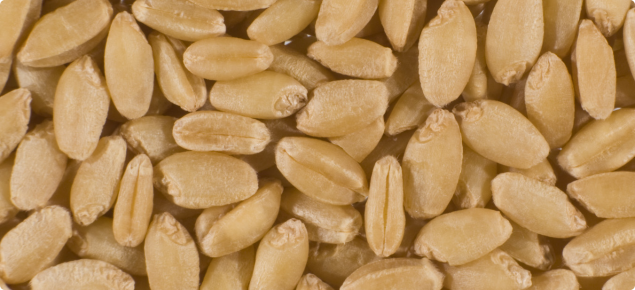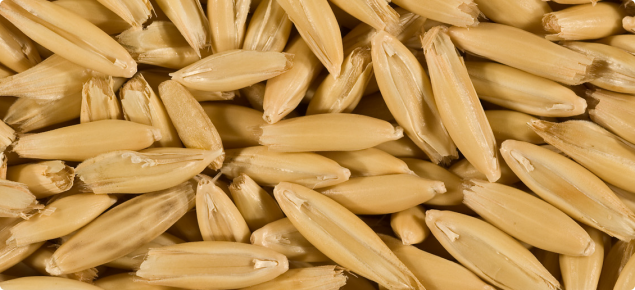Introduction
At seeding, fungicides can be applied to seed (seed dressing) or applied in soil (coated on compound fertiliser or mixed with liquid fertiliser and applied in-furrow) to be taken up by cereal seedlings. Seed dressing fungicides provide protection from seed-borne diseases, such as smuts and bunts. Some seed dressing and/or in-furrow products suppress early foliar diseases, such as yellow spot, powdery mildew and leaf or stripe rust and fungal root rots, such as pythium, rhizoctonia, crown rot and take-all.
Seed dressing and in-furrow fungicides contain one or more active ingredients and are marketed under many different trade names. When choosing seed dressing or in-furrow fungicides, consider the range of diseases that threaten your crop. Consult product labels for registrations, the Australian regulatory database or InfoPest, or see a list of currently registered active ingredients by crop under 'Documents' on the right. Reassess your disease risk before seeding by looking at seasonal forecasts and crop disease forecasts for your local area, all available through the Department of Primary Industries and Regional Development (DPIRD).
Smuts
Smut diseases commonly occur at low levels, but without seed dressings they may increase rapidly and cause significant economic losses to growers. Fungicide seed dressings can control but not always eradicate the smut. When choosing a seed dressing, consider the type of smut that is present. Walk through the crop at heading, looking for diseased plants. Once the smut is identified, choose the right seed dressing and ensure seeds are evenly covered with fungicide. Some smuts can only be controlled by specific registered dressings applied at the correct rate.
Covered smut (common bunt) of wheat
Covered smut of wheat (also known as common bunt or stinking bunt) is potentially the most important smut disease of wheat because there is zero tolerance for it in wheat delivered to Cooperative Bulk Handling Ltd (CBH). It can be both seed- and soil-borne. It is extremely difficult to detect in the field and low levels can remain undetected in harvested grain. Regular pickling is recommended and effectively manages this disease.
If bunt infection does occur, infected seed should not be used; contaminated machinery should be thoroughly cleaned and contaminated paddocks rotated out of wheat for at least one year. Barley, oats and broad leaf crops are not hosts of this disease. In the break crop year, any wheat regrowth should be destroyed before it reaches maturity to prevent carryover of infection. Subsequent wheat crops in the affected paddocks and adjoining paddocks should be sown with fungicide protected seed. Some variety resistance is available.
Flag smut of wheat
Flag smut can be both seed- and soil-borne. Sowing clean seed into a contaminated paddock will not control the disease. It is also important to use a correct seed dressing. Wheat varieties vary in susceptibility to this disease (see current wheat variety guide). Seed dressings are always recommended for susceptible varieties. Where soil-borne infection is known to occur, sow resistant (R) or moderately resistant (MR) varieties with seed dressing. Barley, oats and broad leaf crops are not affected by flag smut.
Loose smut of barley and wheat
Loose smut of barley and wheat is prevalent in areas receiving more than 450mm average annual rainfall. The smut fungus destroys the heads of infected plants, reducing yield by about the same percentage as number of heads infected. This disease is seed borne but the level of seed infection cannot be predicted, however a heavy smut infection in one year will probably produce heavy smut infection in harvested seed. All registered seed dressings reduce incidence of loose smut but the effectiveness varies.Recent work has shown that some products can reduce the infection level of heavily infected seed to nearly zero. Using a highly effective seed dressing will avoid the need to replace heavily infected seed, which was previously recommended.
Other head smuts
Covered smut of barley and loose and covered smut of oats occur generally at low levels. These smuts can be detected in the crop and controlled by regular use of registered seed dressings.
Leaf diseases
Wheat stripe and leaf rusts
Seed dressing or in-furrow fungicides can provide early protection against stripe and leaf rusts of wheat in susceptible or partially resistant varieties. An effective strategy is to delay general seed dressing or in-furrow treatment of susceptible varieties until autumn. Where ‘green bridge’ cereals survive through autumn in local districts there is an increased likelihood that stripe or leaf rust could establish early in young susceptible crops.
A seed dressing or in-furrow fungicide will control rust for 4-6 weeks and provide suppression on seedlings depending on the product and rate. Seed dressings containing fluquinconazole or triticonazole and in-furrow fungicide triadimefon are registered for the suppression of wheat leaf rust. Plants may show minor levels of infection, but this will be significantly lower than in untreated crops and the disease will be easier to manage in spring if follow-up spraying is required.
A range of treatments are registered for stripe rust. Some suppress stripe rust in young crops (such as flutriafol or triadimenol seed dressings). Longer control can be achieved with triticonazole seed dressings (depending on application rate) and some in-furrow fungicides (triadimefon, flutriafol, azoxystrobin with metalaxyl-M). Historically, the longest duration of stripe rust suppression is likely with fluquinconazole seed dressings, or flutriafol in-furrow treatments. No seed dressing or in-furrow fungicides are currently registered for control of wheat stem rust.
Wheat yellow spot, septoria tritici blotch and septoria nodorum blotch
There is now an in-furrow fungicide product registered for suppression of early yellow spot in wheat - the active ingredients are azoxystrobin/metalaxyl-M active and field trials have confirmed its effectiveness. There are some registered seed treatments for septoria tritici blotch, including some flutriafol and triadimenol seed dressings, any fluquinconazole seed dressings and flutriafol in-furrow treatments. Currently, septoria tritici blotch is a minor disease of wheat crops in WA. Of the currently registered seed dressings and in-furrow fungicides, none are registered for control of the much more common disease septoria nodorum blotch as none have demonstrated control of this disease.
Barley scald and powdery mildew
Barley scald is most likely to occur where susceptible barley is sown early or into previously infected stubbles, especially in medium to high rainfall regions. Registered products will help suppress the disease.
The severity of barley powdery mildew varies seasonally. It can often significantly impact on young crops. Seed dressings or in-furrow fungicides are recommended to delay the onset of disease and to reduce its severity and impact on yields. Treatment will provide substantial benefits under heavy early disease intensity, reducing the requirement for early foliar fungicide application.
Barley leaf rust
The active ingredient fluxapyroxad (product Systiva®) is now registered as a seed dressing for the control of barley leaf rust. Uniform® (containing active ingredients azoxystrobin and metalaxyl-M) and some flutriafol 500g/L products (Intake® Hiload Gold and Intake® Combi Sapphire) are currently registered in-furrow for suppression of barley leaf rust.
Barley net blotch (net-form and spot-form)
Barley net blotches are becoming more common throughout the wheatbelt, with net-type net blotch more common in medium to high rainfall regions. The primary source of net blotch infection is infected stubbles which spread disease to seedlings. Net-form and spot-form net blotch can cause more than 30% yield loss in susceptible varieties when grown on previous-season infected stubbles.
Until recently, seed dressings were only registered to control seedborne net-type net blotch, however, seed infection is not considered an important part of the spread of this disease in WA. The active ingredient fluxapyroxad (product Systiva®) is registered for both seed borne and stubble borne inoculum of both spot-type net blotch and net-type net blotch. Uniform® is registered as an in-furrow fungicide for suppression of both net and spot-type net blotch and flutriafol is registered as an in-furrow fungicide for suppression of net-type net blotch.
Root fungal diseases
Wheat take-all
In high rainfall areas, second wheat crops or wheat crops after grassy pasture represent higher risk for take-all. When wheat is to be sown in a high risk take-all paddock, fluquinconazole seed dressings or many of the in-furrow fungicides can reduce take-all risk.
Pythium root rot, rhizoctonia and crown rot
A range of seed dressing and in-furrow fungicides are registered for pythium species, rhizoctonia and crown rot in wheat and barley.
Disease diagnosis
Contact Department of Primary Industries and Regional Development's Diagnostic Laboratory Services (DDLS) for assistance with disease identification in seed and plants. Telephone +61 (0)8 9368 3351 or see the DDLS - Plant pathology services page.
Cautions about using fungicide seed dressings
Read and follow directions on fungicide labels carefully.
In some situations, certain fungicide seed dressings may reduce coleoptile length, which could lead to 'silly seedling syndrome' (leaves grow under soil surface but don't emerge), particularly if short coleoptile varieties or deep sowing are used. Check chemical labels for this information. Coleoptile shortening may also result from use of dinotroaniline herbicides (trifluralin, pendimethalin, oryzalin). Take care where coleoptile-shortening seed dressings are used together with these herbicides, particularly where it is difficult to obtain good depth control of herbicide incorporation and seed placement, such as in sandy soils.
Pickled seed should not be used as animal feed and should not be delivered to CBH.
Fungicide resistance
Fungicide resistance to DMI (group 3) fungicides has been detected in barley diseases net form net blotch, spot form net blotch and powdery mildew. Resistance and reduced sensitivity to SDHI (group 7) fungicides has been detected in spot and net form net blotch. Reduce risk associated with fungicide resistance by reducing disease risk through integrated disease management approaches such as crop rotation, use fungicide products according to label recommendations and rotate or alternate fungicide activity groups.
Tables of registered seed dressing and in-furrow fungicides for WA cereal crops
These are available to download from this page under 'Documents' on the right. These are a guide only and product labels should be read carefully before application. To help us keep these tables updated please contact Kith Jayasena or Ciara Beard with any new registration information.
Disclaimer: Mention of trade names does not imply endorsement or preference of any company’s product by Department of Agriculture and Food, Western Australia and any omission of a trade name is unintentional. Recommendations are current at the time this page was prepared.



